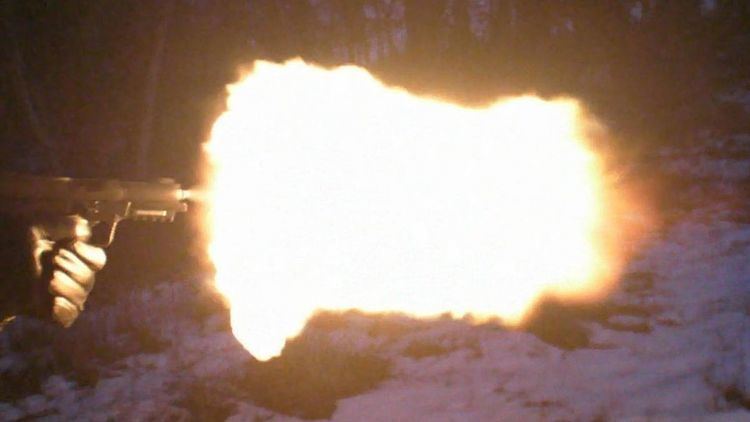 | ||
Muzzle flash is the visible light of a muzzle blast, which expels high temperature, high pressure gases from the muzzle of a firearm. The blast and flash are caused by the combustion products of the gunpowder, and any remaining unburned powder, mixing with the ambient air. The size and shape of the muzzle flash is dependent on the type of ammunition being used and the individual characteristics of firearm and any devices attached to the muzzle (such as a muzzle brake or flash suppressor).
Contents
Muzzle blast
The muzzle flash is often broken down into two components, an auditory component and a non-auditory component. The auditory component, the sound of the muzzle blast, is important because it can cause hearing loss or give away the gun's position, while the non-auditory component, the overpressure wave, can cause damage to items near the blast.
Sound
The sound of a gunshot may have two sources; the muzzle blast itself, and any sound produced by a transonic or supersonic projectile. Suppressors help to reduce the level of sound of a firearm, by providing a large area for the propellant gas to expand and cool before release.
Overpressure wave
The overpressure wave from the muzzle blast of a firearm can contain a significant amount of energy because it travels at an extremely high velocity. Residual pressures at the muzzle can be a significant fraction of the peak chamber pressure, especially when slow burning powders or short barrels are used. This energy can also be harnessed by a muzzle brake to reduce the recoil of the firearm, or by a muzzle booster to provide energy to operate the action.
Problems caused by muzzle blast
Muzzle blasts can easily exceed sound pressure levels of 140 decibels, which can cause permanent hearing loss even with brief and infrequent exposure. With big guns such as artillery, that danger can extend outwards a significant distance from the muzzle.
The force of the muzzle blast can cause damage to items near the muzzle, and with artillery, the energy is sufficiently large to cause severe damage to surrounding structures and vehicles. It furthermore can violently raise dust and debris when firing rifles from prone position and so give away the position. Preventive actions may consist in wetting dry ground or covering the area around the muzzle with a tarpaulin.
Muzzle flash
The muzzle flash refers to the light emitted by the muzzle blast, both visible light and infrared. Both heat and pressure can result in light being emitted.
Muzzle flash characteristics
Muzzle flash can be broken down into five distinct components.
Suppression
Muzzle flash, particularly the long duration secondary flash, is an inherent problem in most firearms. Due to its brightness, muzzle flash can temporarily blind the shooter, or give away the shooter's location, especially at night. Ingestion of the muzzle flash from aircraft mounted guns has also been implicated in compressor stall and flameout, causing loss of aircraft.
Flash suppressors attempt to suppress the flash mechanically, by interfering with the shock wave using either a cone or a series of slots at the muzzle of the firearm. However, since the primary cause of the secondary flash is combustion of hydrogen and carbon monoxide, chemical approaches are also used. In World War I, bags of sodium chloride (table salt) were placed in front of the propellant charges of artillery to suppress the flash. Addition of a few percent of alkali salts to the powder for flash suppression is common, typically salts of potassium such as potassium chloride, potassium sulfate, potassium carbonate, and potassium bicarbonate. In both cases, the salts act as catalysts, and interfere with the hydrogen-oxygen combustion to reduce the muzzle flash. The side effects of the alkali salts is a reduction in power, an increase in smoke, and fouling and corrosion of the firearm and nearby equipment (a significant concern with aircraft guns). Ammonium chloride and ammonium nitrate salts have also been tried with success.
Detection, with muzzle blast
Gunfire locators detect muzzle blast with microphones and triangulate the location where the shots were fired. They are commercially available, and have been installed in many high crime areas of large cities. They provide a fairly precise location of the source of a shot fired outdoors—99% to within 33 feet (10 m) or better—and can provide it to police within seconds of a firing.
Muzzle flashes create distinct signatures that can be located using infrared imaging technology. Technology is being developed to detect enemy muzzle flashes before the projectile reaches its target.
